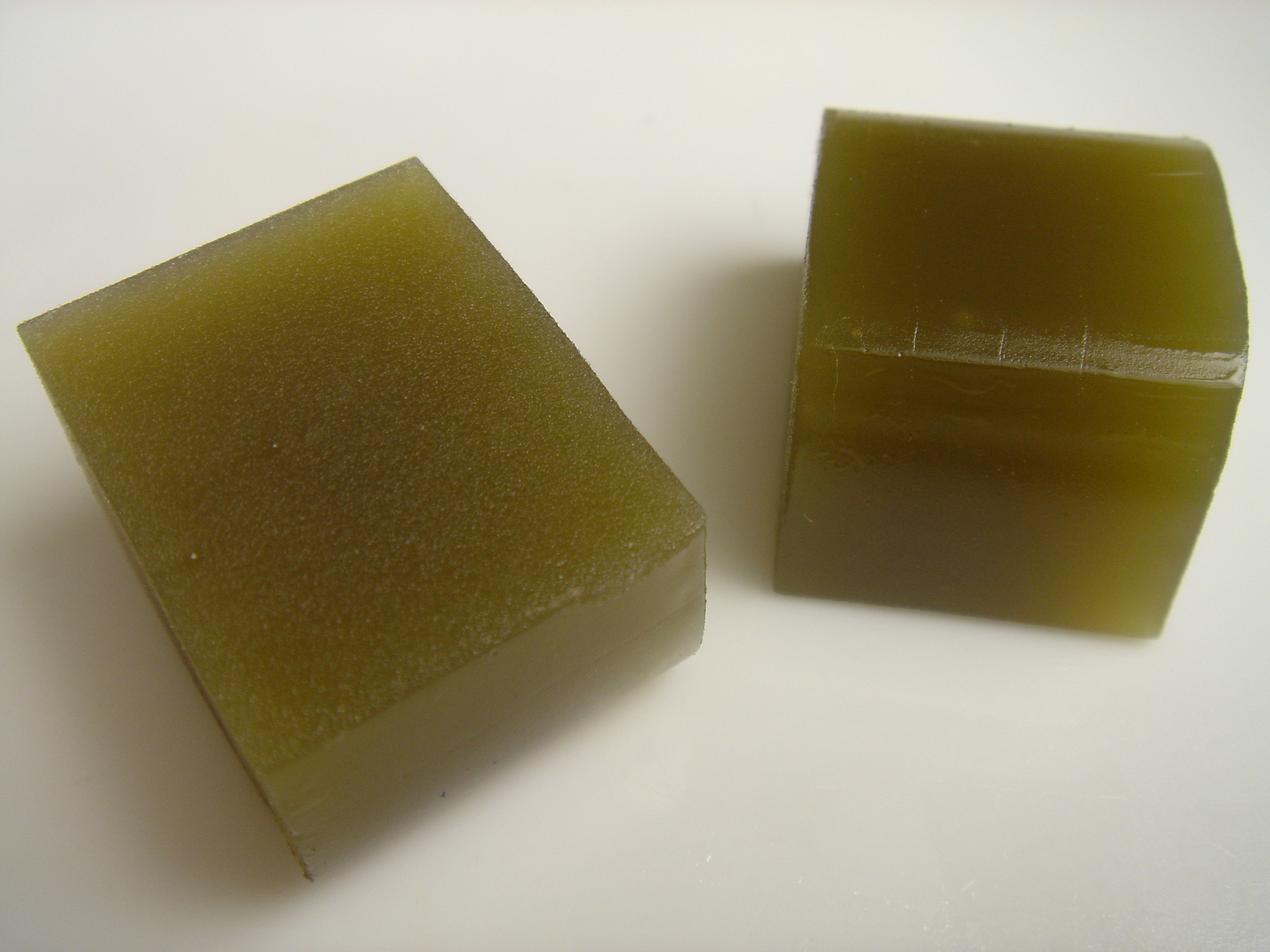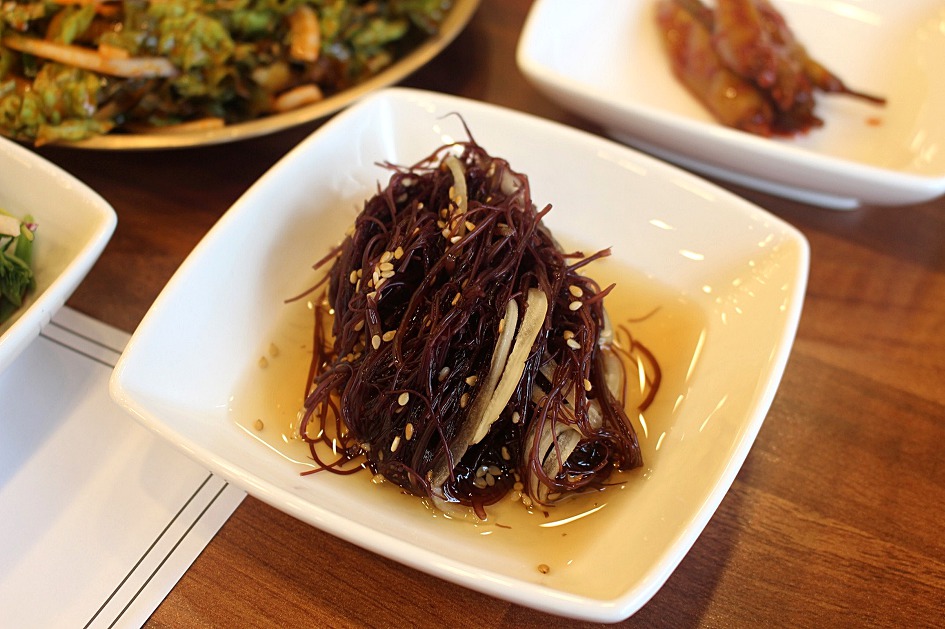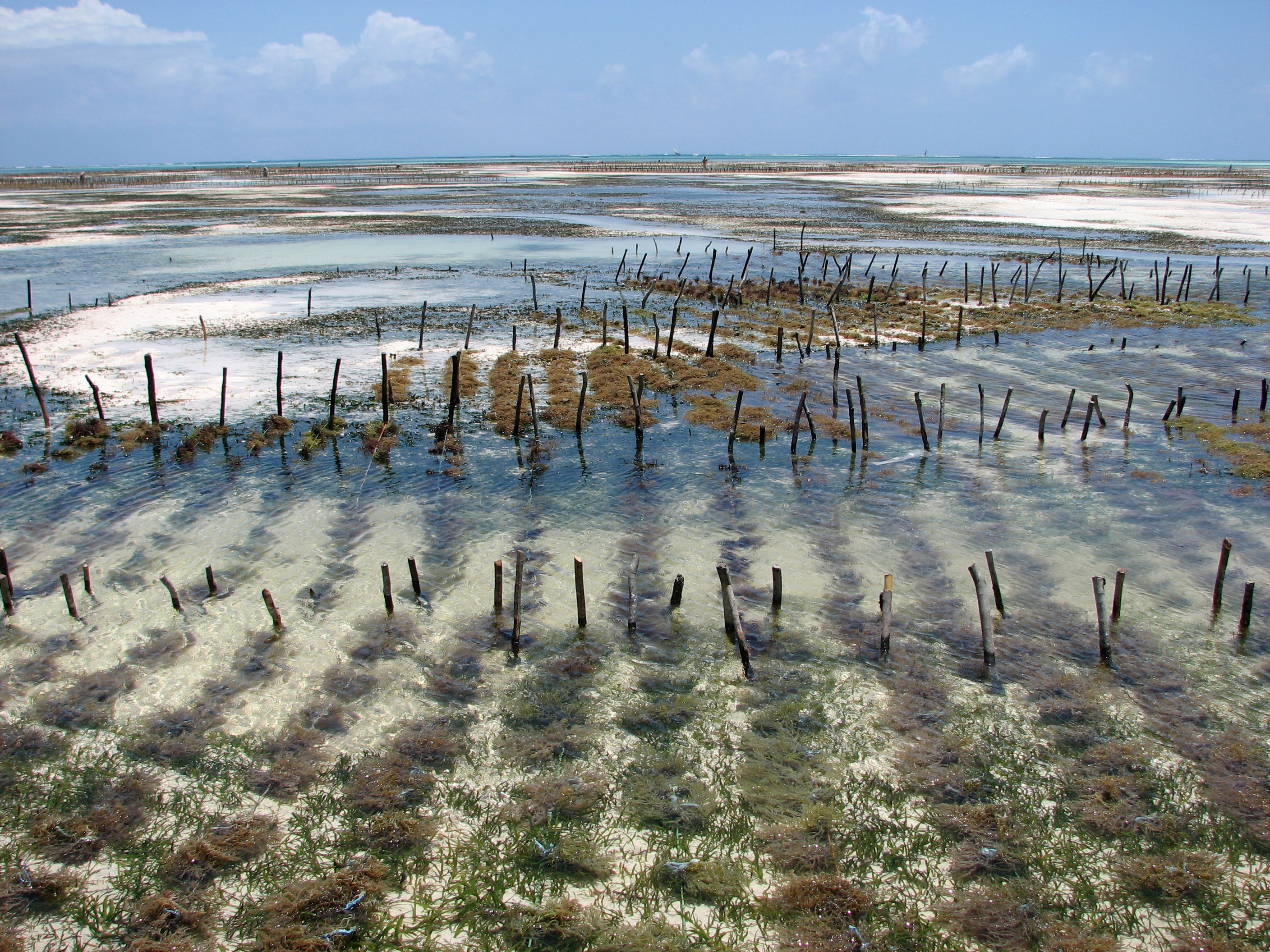|
Agar-agar
Agar ( or ), or agar-agar, is a jelly-like substance consisting of polysaccharides obtained from the cell walls of some species of red algae, primarily from " ogonori" and " tengusa". As found in nature, agar is a mixture of two components, the linear polysaccharide agarose and a heterogeneous mixture of smaller molecules called agaropectin. It forms the supporting structure in the cell walls of certain species of algae and is released on boiling. These algae are known as agarophytes, belonging to the Rhodophyta (red algae) phylum. The processing of food-grade agar removes the agaropectin, and the commercial product is essentially pure agarose. Agar has been used as an ingredient in desserts throughout Asia and also as a solid substrate to contain culture media for microbiological work. Agar can be used as a laxative; an appetite suppressant; a vegan substitute for gelatin; a thickener for soups; in fruit preserves, ice cream, and other desserts; as a clarifying agent in bre ... [...More Info...] [...Related Items...] OR: [Wikipedia] [Google] [Baidu] |
Agarose
Agarose is a heteropolysaccharide, generally extracted from certain red algae. It is a linear polymer made up of the repeating unit of agarobiose, which is a disaccharide made up of D-galactose and 3,6-anhydro-L-galactopyranose. Agarose is one of the two principal components of agar, and is purified from agar by removing agar's other component, agaropectin. Agarose is frequently used in molecular biology for the separation of large molecules, especially DNA, by electrophoresis. Slabs of agarose gels (usually 0.7 - 2%) for electrophoresis are readily prepared by pouring the warm, liquid solution into a mold. A wide range of different agaroses of varying molecular weights and properties are commercially available for this purpose. Agarose may also be formed into beads and used in a number of chromatographic methods for protein purification. Structure Agarose is a linear polymer with a molecular weight of about 120,000, consisting of alternating D- galactose and 3,6-an ... [...More Info...] [...Related Items...] OR: [Wikipedia] [Google] [Baidu] |
Appetite Suppressant
An anorectic is a drug that reduces appetite, resulting in lower food consumption, leading to weight loss. These substances work by affecting the central nervous system or certain neurotransmitters to create a feeling of fullness or reduce the desire to eat. The understanding of anorexiant effects is crucial in the development of interventions for weight management, eating disorders, and related health concerns. The anorexiant effect can be induced through diverse mechanisms, ranging from hormonal regulation to neural signaling. Ghrelin, leptin, and peptide YY are among the hormones involved in appetite control. Additionally, neurotransmitters such as serotonin and dopamine in the central nervous system contribute significantly to the regulation of food intake. By contrast, an appetite stimulant is referred to as orexigenic. The term is (from the Ancient Greek language, Greek and ), and such drugs are also known as anorexigenic, anorexiant, or appetite suppressant. History Us ... [...More Info...] [...Related Items...] OR: [Wikipedia] [Google] [Baidu] |
Gracilaria Edulis
''Gracilaria'', also known as irish moss or ogonori, is a genus of red algae in the family Gracilariaceae. It is notable for its economic importance as an agarophyte meaning that it is used to make agar, as well as its use as a food for humans and various species of shellfish. Various species in the genus are cultivated among Asia, South America, Africa and Oceania. They produce over 90% of the world's agar. Taxonomy ''Gracilaria'' contains the following subtaxa: *'' Gracilaria abbottiana'' M.D.Hoyle *'' Gracilaria abyssalis'' Gurgel & Yoneshigue-Valentin *'' Gracilaria aculeata'' (Hering) Papenfuss *'' Gracilaria aggregata'' Hooker f. & Harvey *'' Gracilaria ambigua'' Greville *'' Gracilaria apiculata'' P.Crouan & H.Crouan ** ''Gracilaria apiculata'' subsp. ''candelabriformis'' Gurgel, Fredericq & J.N.Norris *'' Gracilaria apiculifera'' J.Agardh ** ''Gracilaria arcuata'' f. ''rhizophora'' Børgesen ** ''Gracilaria arcuata'' var. ''attenuata'' Umamaheswara Rao ** ''Gracilaria ... [...More Info...] [...Related Items...] OR: [Wikipedia] [Google] [Baidu] |
Tokoroten
is a gelatinous dish in Japanese cuisine, made from agarophyte seaweed. It was traditionally made by boiling ''tengusa'' (''Gelidium amansii'') and allowing the mixture to congeal into a jelly. The jelly is then pressed through an extruding device and shaped into noodles. Unlike gelatin desserts, ''tokoroten'' has a firmer texture. ''Tokoroten'' can be eaten hot (in solution) or cold (as a gel). Flavorings and garnishes can vary from region to region. In the present day, it is common to eat it with a mixture of vinegar and soy sauce, and sometimes nori, hot pepper, or sesame. In the Kansai region, ''tokoroten'' is eaten as a dessert with ''kuromitsu'' syrup. History ''Tokoroten'' has been eaten in Japan for over a thousand years. It is thought to have been introduced to Japan from China during the Nara period. During the Edo period, it was popular during the summer as a snack. It was originally made to be eaten immediately and was commonly sold around factories. In the 17 ... [...More Info...] [...Related Items...] OR: [Wikipedia] [Google] [Baidu] |
National Library Of Australia
The National Library of Australia (NLA), formerly the Commonwealth National Library and Commonwealth Parliament Library, is the largest reference library in Australia, responsible under the terms of the ''National Library Act 1960'' for "maintaining and developing a national collection of library material, including a comprehensive collection of library material relating to Australia and the Australians, Australian people", thus functioning as a national library. It is located in Parkes, Australian Capital Territory, Parkes, Canberra, Australian Capital Territory, ACT. Created in 1960 by the ''National Library Act'', by the end of June 2019 its collection contained 7,717,579 items, with its manuscript material occupying of shelf space. The NLA also hosts and manages the Trove cultural heritage discovery service, which includes access to the Australian Web Archive and National edeposit (NED), a large collection of digitisation, digitised newspapers, official documents, manuscrip ... [...More Info...] [...Related Items...] OR: [Wikipedia] [Google] [Baidu] |
Trove
Trove is an Australian online library database owned by the National Library of Australia in which it holds partnerships with source providers National and State Libraries Australia, an aggregator and service which includes full text documents, digital images, bibliographic and holdings data of items which are not available digitally, and a free faceted-search engine as a discovery tool. Content The database includes archives, images, newspapers, official documents, archived websites, manuscripts and other types of data. it is one of the most well-respected and accessed GLAM services in Australia, with over 70,000 daily users. Based on antecedents dating back to 1996, the first version of Trove was released for public use in late 2009. It includes content from libraries, museums, archives, repositories and other organisations with a focus on Australia. It allows searching of catalogue entries of books in Australian libraries (some fully available online), academic and ... [...More Info...] [...Related Items...] OR: [Wikipedia] [Google] [Baidu] |
Eucheuma
''Eucheuma'', commonly known as sea moss or gusô (), is a rhodophyte seaweed that may vary in color (purple, brown, and green). ''Eucheuma'' species are used in the production of carrageenan, an ingredient for cosmetics, food processing, and industrial manufacturing, as well as a food source for people in the Philippines, Caribbean and parts of Indonesia and Malaysia. ''Eucheuma cottonii'' – which grows in the Caribbean and cultivated in the Philippines – is the particular species known as gusô. Other species include ''Betaphycus gelatinae'', ''Eucheuma denticulatum'', and several species of the genus ''Kappaphycus'', including ''K. alvarezii''. Since the mid-1970s, ''Kappaphycus'' and ''Eucheuma'' have been a major source for the expansion of the carrageenan industry. Commercial seaweed farming of gusô (as well as '' Kappaphycus'') was pioneered in the Philippines. Though commercially significant, species of ''Eucheuma'' are difficult to identify without the aid of close ... [...More Info...] [...Related Items...] OR: [Wikipedia] [Google] [Baidu] |
Malay Language
Malay ( , ; , Jawi alphabet, Jawi: ) is an Austronesian languages, Austronesian language spoken primarily by Malays (ethnic group), Malays in several islands of Maritime Southeast Asia and the Malay Peninsula on the mainland Asia. The language is an official language of Brunei, Malaysia, and Singapore. Indonesian language, Indonesian, a standardized variety of Malay, is the official language of Indonesia and one of the working languages of East Timor. Malay is also spoken as a regional language of Malays (ethnic group), ethnic Malays in Indonesia and the Thai Malays, southern part of Thailand. Altogether, it is spoken by 60 million people across Maritime Southeast Asia. The language is pluricentric and a ISO 639 macrolanguage, macrolanguage, i.e., a group of Mutual intelligibility, mutually intelligible speech varieties, or dialect continuum, that have no traditional name in common, and which may be considered distinct languages by their speakers. Several varieties of it ar ... [...More Info...] [...Related Items...] OR: [Wikipedia] [Google] [Baidu] |
Sizing
Sizing or size is a substance that is applied to, or incorporated into, other materials—especially papers and textiles—to act as a protective filler or glaze. Sizing is used in papermaking and textile manufacturing to change the absorption and wear characteristics of those materials. Sizing is used for oil-based surface preparation for gilding (sometimes called ''mordant'' in this context). It is used by painters and artists to prepare paper and textile surfaces for some art techniques. Sizing is used in photography to increase the sharpness of a print, to change the glossiness of a print, or for other purposes depending on the type of paper and printing technique. Fibers used in composite materials are treated with various sizing agents to promote adhesion with the matrix material. Sizing is used during paper manufacture to reduce the paper's tendency when dry to absorb liquid, with the goal of allowing inks and paints to remain on the surface of the paper and to dry t ... [...More Info...] [...Related Items...] OR: [Wikipedia] [Google] [Baidu] |
Brewing
Brewing is the production of beer by steeping a starch source (commonly cereal grains, the most popular of which is barley) in water and #Fermenting, fermenting the resulting sweet liquid with Yeast#Beer, yeast. It may be done in a brewery by a commercial brewer, at home by a homebrewer, or communally. Brewing has taken place since around the 6th millennium BC, and archaeological evidence suggests that emerging civilizations, including ancient Egypt, China, and Mesopotamia, brewed beer. Since the nineteenth century the #brewing industry, brewing industry has been part of most western economies. The basic ingredients of beer are water and a Fermentation, fermentable starch source such as malted barley. Most beer is fermented with a brewer's yeast and flavoured with hops. Less widely used starch sources include millet, sorghum and cassava. Secondary sources (adjuncts), such as maize (corn), rice, or sugar, may also be used, sometimes to reduce cost, or to add a feature, such ... [...More Info...] [...Related Items...] OR: [Wikipedia] [Google] [Baidu] |






